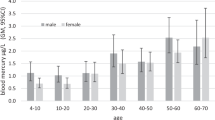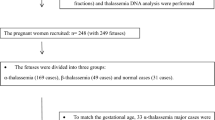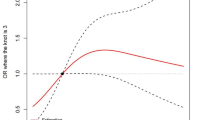Abstract
Background
Maternal blood total mercury (THg) is a biomarker for prenatal methylmercury (MeHg) exposure. Few studies have quantified both blood THg and MeHg during pregnancy, and few studies have reported longitudinal trends.
Objectives
We analyzed blood THg and MeHg in a cohort of pregnant mothers in Charleston, South Carolina (n = 83), and investigated whether blood THg or MeHg changed between early and late gestation.
Methods
THg and MeHg were analyzed in blood samples from early (12 ± 1.7 weeks) and late (35 ± 2.2 weeks) gestation.
Results
Blood %MeHg (of THg) averaged 63% (range: 10–114%) and 61% (range: 12–117%) during early and late gestation, respectively. In unadjusted analyses, blood MeHg decreased from early to late pregnancy (paired t-test, p = 0.04), while THg did not change (paired t-test, p = 0.34). When blood MeHg was normalized by the hematocrit, this decrease was no longer statistically significant (paired t-test, p = 0.09).
Conclusions
In unadjusted analyses, blood MeHg, but not THg, decreased significantly between early and late gestation; this decrease was due in part to hemodilution. Percent MeHg (of THg) varied by up to one order of magnitude. Results highlight the importance of Hg speciation in maternal blood samples to assess prenatal MeHg exposure.
This is a preview of subscription content, access via your institution
Access options
Subscribe to this journal
Receive 6 print issues and online access
$259.00 per year
only $43.17 per issue
Buy this article
- Purchase on SpringerLink
- Instant access to full article PDF
Prices may be subject to local taxes which are calculated during checkout


Similar content being viewed by others
References
World Health Organization (WHO). Environmental Health Criteria 101: Methylmercury. Geneva: World Health Organization; 1990. http://www.inchem.org/documents/ehc/ehc/ehc101.htm. Accessed 5 Dec 2017.
National Research Council (NRC). Toxicological effects of methylmercury. Washington, DC: National Academy Press; 2000. http://www.ncbi.nlm.nih.gov/books/NBK225778/. Accessed 5 Dec 2017.
Clarkson TW, Magos L. The toxicology of mercury and its chemical compounds. Crit Rev Toxicol. 2006;36:609–62.
Cernichiari E, Brewer R, Myers GJ, Marsh DO, Lapham LW, Cox C, et al. Monitoring methylmercury during pregnancy: maternal hair predicts fetal brain exposure. Neurotoxicology. 1995;16:705–10.
Liang L, Evens C, Lazoff S, Woods JS, Cernichiari E, Horvat M, et al. Determination of methyl mercury in whole blood by ethylation-GC-CVAFS after alkaline digestion-solvent extraction. J Anal Toxicol. 2000;24:328–32.
DeRouen TA, Martin MD, Leroux BG, Townes BD, Woods JS, Leitao J, et al. Neurobehavioral effects of dental amalgam in children. J Am Med Assoc. 2006;295:1784–92.
Rothenberg SE, Keiser S, Ajami NJ, Wong MC, Gesell J, Petrosino JF, et al. The role of gut microbiota in fetal methylmercury exposure: insights from a pilot study. Toxicol Lett. 2016;242:60–67.
Vahter M, Åkesson A, Lind B, Björs U, Schütz A, Berglund M. Longitudinal study of methylmercury and inorganic mercury in blood and urine of pregnant and lactating women, as well as in umbilical cord blood. Environ Res Sect A. 2000;84:186–94.
Wells EM, Herbstman JB, Lin YH, Hibbeln JR, Halden RU, Witter FR, et al. Methyl mercury, but not inorganic mercury, associated with higher blood pressure during pregnancy. Environ Res. 2017;154:247–52.
You C-H, Kim B-G, Jo E-M, Kim G-Y, Yu B-C, Hong M-G, et al. The relationship between the fish consumption and blood total/methyl-mercury concentration of coastal area in Korea. Neurotoxicology. 2012;33:676–82.
Koren O, Goodrich JK, Cullender TC, Spor A, Laitinen K, Backhed HK, et al. Host remodeling of the gut microbiome and metabolic changes during pregnancy. Cell. 2012;150:470–80.
Block G, DiSogra C. WIC Dietary Assessment Validation Study. Final Report. Alexandria, VA: U.S. Department of Agriculture, Food and Nutrition Service; 1994. www.nutritionquest.com. Accessed 5 Dec 2017.
Hollis BW, Johnson D, Hulsey TC, Ebeling M, Wagner CL. Vitamin D supplementation during pregnancy: double blind, randomized clinical trial of safety and effectiveness. J Bone Miner Res. 2011;26:2341–57.
Hong C, Yu X, Liu J, Cheng Y, Rothenberg SE. Low-level methylmercury exposure through rice ingestion in a cohort of pregnant mothers in rural China. Environ Res. 2016;150:519–27.
Rothenberg SE, Windham-Myers L, Creswell JE. Rice methylmercury exposure and mitigation: a comprehensive review. Environ Res. 2014;133:407–23.
Rothenberg SE, Yu X, Liu J, Biasini FJ, Hong C, Jiang X, et al. Maternal methylmercury exposure through rice ingestion and offspring neurodevelopment: a prospective cohort study. Int J Hyg Environ Health. 2016b;219:832–42.
Grandjean P, Weihe P, White RF, Debes F, Araki S, Yokoyama K, et al. Cognitive deficit in 7-year old children with prenatal exposure to methylmercury. Neurotoxicol Teratol. 1997;19:417–28.
Mahaffey KR, Clickner RP, Jeffries RA. Adult women’s blood mercury concentrations vary regionally in the United States: association with patterns of fish consumption (NHANES 1999-2004). Environ Health Perspect. 2009;117:47–53.
Pichichero ME, Gentile A, Giglio N, Umido V, Clarkson T, Cernichiardi E, et al. Mercury levels in newborns and infants after receipt of thimerosal-containing vaccines. Pediatrics. 2008;121:e208–14. https://doi.org/10.1542/peds.2006-3363
Rothenberg SE, Korrick SA, Fayad R. The influence of obesity on blood mercury levels for U.S. non-pregnant adults and children: NHANES 2007–2010. Environ Res. 2015;138:173–80.
Rowland IR, Robinson RD, Doherty RA. Effects of diet on mercury metabolism and excretion in mice given methylmercury: role of gut flora. Arch Environ Health. 1984;39:401–8.
Seko Y, Miura T, Takahashi M, Koyama T. Methyl mercury decomposition in mice treated with antibiotics. Acta Pharmacol Toxicol. 1981;49:259–65.
Institute of Medicine (IOM). Weight gain during pregnancy: reexamining the guidelines. 2009. https://www.nationalacademies.org/hmd/~/media/Files/Report%20Files/2009/Weight-Gain-During-Pregnancy-Reexamining-the-Guidelines/Report%20Brief%20-%20Weight%20Gain%20During%20Pregnancy.pdf Accessed 5 Dec 2017.
U.S. Environmental Protection Agency (U.S. EPA). Appendix to method 1631, total mercury in tissue, sludge, sediment, and soil by acid digestion and BrCl oxidation, EPA-821-R-01-013. 2001; https://nepis.epa.gov/Exe/ZyPDF.cgi/40001F6A.PDF?Dockey=40001F6A.PDF. Accessed 5 Dec 2017.
U.S. Environmental Protection Agency (U.S. EPA). Method 1631, Revision E: mercury in water by oxidation, purge and trap, and cold vapor atomic fluorescence spectrometry, EPA-821-R-02-019. 2002. https://nepis.epa.gov/Exe/ZyPDF.cgi/P1008IW8.PDF?Dockey=P1008IW8.PDF. Accessed 5 Dec 2017
U.S. Environmental Protection Agency (U.S. EPA). Method 1630, methyl mercury in water by distillation aqueous ethylation, purge and trap, and cold vapor atomic spectrometry, EPA-821-R-01-020. 2001. https://www.epa.gov/sites/production/files/2015-08/documents/method_1630_1998.pdf Accessed 5 Dec 2017
U.S. Environmental Protection Agency (U.S. EPA). 40 Code of Federal Regulation, Appendix B to Part 136: definition and procedure for the determination of the method detection limit-revision 1.11. 2011. https://www.gpo.gov/fdsys/pkg/CFR-2011-title40-vol23/pdf/CFR-2011-title40-vol23-part136-appB.pdf Accessed 5 Dec 2017.
Voegborlo RB, Matsuyama A, Adimado AA, Akagi H. Head hair total mercury and methylmercury levels in some Ghanaian individuals for the estimation of their exposure to mercury: preliminary studies. Bull Environ Contam Toxicol. 2010;84:34–38.
Schafer JL. Analysis of incomplete multivariate data. London: Chapman & Hall; 1997.
Hytten F. Blood volume changes in normal pregnancy. Clin Haematol. 1985;14:601–12.
Schell LM, Czerwinski S, Stark AD, Parsons PJ, Gomez M, Samelson R. Variation in blood lead and hematocrit levels during pregnancy in a socioeconomically disadvantaged population. Arch Environ Health. 2000;55:134–40.
Mahaffey KR, Clickner RP, Bodurow CC. Blood organic mercury and dietary mercury intake: National Health and Nutrition Examination Survey, 1999 and 2000. Environ Health Perspect. 2004;112:562–70.
Morrissette J, Takser L, St-Amour G, Smargiassi A, Lafond J, Mergler D. Temporal variation of blood and hair mercury levels in pregnancy and relation to fish consumption history in a population living along the St. Lawrence River. Environ Res. 2004;95:363–74.
U.S. Environmental Protection Agency (U.S. EPA). Trends in blood mercury concentrations and fish consumption among U.S. women of childbearing age NHANES, 1999–2010. EPA-823-R-13-002. 2013. https://nepis.epa.gov/Exe/ZyPDF.cgi/P100LP7Q.PDF?Dockey=P100LP7Q.PDF Accessed 5 Dec 2017.
Traynor S, Kearney G, Olson D, Hilliard A, Palcic J. Fish consumption patterns and mercury exposure levels among women of childbearing age in Duval County, Florida. J Environ Health. 2013;75:8–15.
Burger J, Stephens WL Jr, Boring CS, Kuklinski M, Gibbons JW, Gochfeld M. Factors in exposure assessment: ethnic and socioeconomic differences in fishing and consumption of fish caught along the Savannah River. Risk Anal. 1999;19:427–38.
Burch JB, Robb SW, Puett R, Cai B, Wilkerson R, Karmous W, et al. Mercury in fish and adverse reproductive outcomes: results from South Carolina. Int J Health Geogr. 2014;13:30 https://doi.org/10.1186/1476-072X-13-30
Acknowledgements
The authors wish to thank the study coordinators, including Judy Shary and Martha Murphy, who oversaw participant recruitment and data collection. The content is solely the responsibility of the authors and does not necessarily represent the official views of the study sponsors. The study sponsors did not play a role in the study design, in the collection, analysis, and interpretation of data, in the writing of the report, or in the decision to submit the paper for publication.
Funding
This study was supported in part by grants to S. Rothenberg from the U.S. National Institute of Environmental Health Sciences (R21 ES026412), the U.S. National Institute of Health Loan Replacement Program (L30 ES023165), and the University of South Carolina Office of Research (Aspire-1). This study was also supported in part by a grant to C. Wagner from the W.K. Kellogg Foundation.
Author information
Authors and Affiliations
Corresponding author
Ethics declarations
Conflict of interest
The authors declare that they have no conflict of interest.
Electronic supplementary material
Rights and permissions
About this article
Cite this article
Donohue, A., Wagner, C.L., Burch, J.B. et al. Blood total mercury and methylmercury among pregnant mothers in Charleston, South Carolina, USA. J Expo Sci Environ Epidemiol 28, 494–504 (2018). https://doi.org/10.1038/s41370-018-0033-1
Received:
Revised:
Accepted:
Published:
Issue date:
DOI: https://doi.org/10.1038/s41370-018-0033-1
Keywords
This article is cited by
-
Potential Factors Associated with the Blood Metal Concentrations of Reproductive-Age Women in Taiwan
Exposure and Health (2024)
-
Effects of low doses of methylmercury (MeHg) exposure on definitive endoderm cell differentiation in human embryonic stem cells
Archives of Toxicology (2023)
-
Total Blood Mercury Predicts Methylmercury Exposure in Fish and Shellfish Consumers
Biological Trace Element Research (2022)
-
Total blood mercury and its determinants in New Zealand children and adults
Journal of Exposure Science & Environmental Epidemiology (2021)
-
Exposure to total and methylmercury among pregnant women in Suriname: sources and public health implications
Journal of Exposure Science & Environmental Epidemiology (2021)



